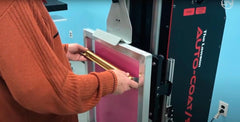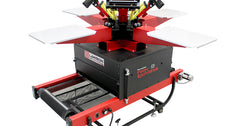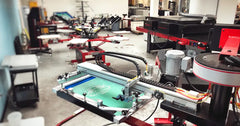Not sure which screen printing emulsion is best for you? Don’t worry, we will help you select the right one.
Having the right screen printing supplies affects your entire printing process. For example, when it comes to selecting photo emulsion. Each emulsion type has its advantages and its disadvantages. Your choices vary between liquid emulsion and emulsion sheets (also known as capillary film). The three main types of emulsion are photopolymer, diazo, and dual cure. For each type and style there are various pros and cons that mainly relate to exposure times, light source, and the amount of detail in your image. Don’t worry, we will help you select the right type of photo emulsion to use for screen printing.
Knowing your screen printing experience level, and understanding the type of exposure unit you use is a big help when deciding between the different emulsions. If you are new to t-shirt printing, or have longer exposure times because you are not using an LED exposure unit, a dual-cure might be a good option for you. Dual-cure emulsion has a wider exposure latitude. Having a wider latitude makes it easier to develop (wash-out) your screen if you under or over expose your emulsion coated screen. I recommend beginner silk screeners start out with Lawson Dual-Cure 310. Lawson’s Dual-Cure 310 is very user-friendly and economical.
If you are a screen printer using an LED exposure unit, fast exposure times is key. The fastest exposing screen printing emulsions are photopolymers. Photopolymers are highly sensitive to UV/LED light. The chemistry of photopolymer emulsions make them great for fine details and half-tones. If you choose to use a photopolymer, I recommend either Lawson’s SBQ-1077, especially if you are using a computer-to-screen (CTS) imaging device, or Ulano's Blue, which is a good photopolymer that is more forgiving and works great with screen printing film positives.
If you do not want to deal with the mess of applying liquid emulsion, a great alternative are emulsion sheets, also known as capillary film or direct film. These emulsion sheets are easy to apply, as shown in our video "How To Apply Screen Printing Capillary Film Emulsion To A Frame", to your screen printing frame and provide consistency. Capillary film can be exposed with LED exposure units or weaker fluorescent tube units. The most popular photo emulsion sheets are Ulano EZ-Film.
No matter what type of silk screen emulsion you use, there are a few pro tips to getting the most out of your product. First, this screen printing supply item can be stored in the refrigerator. Emulsion stored in the refrigerator helps extend its shelf life. Just make sure to not let it freeze. In conjunction with refrigerated storage, you’ll want to keep all emulsion out of excessive heat.









